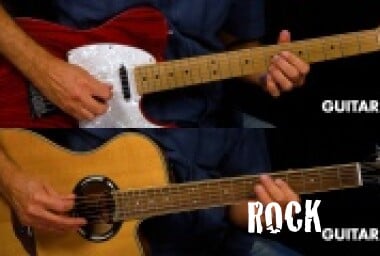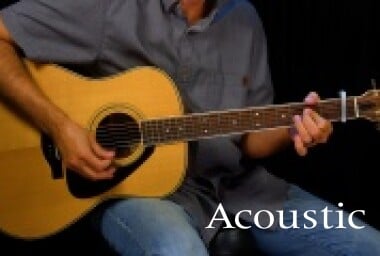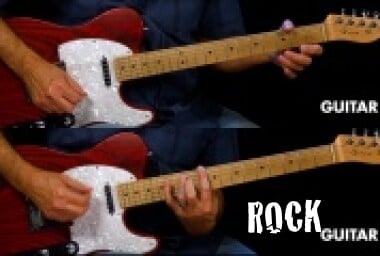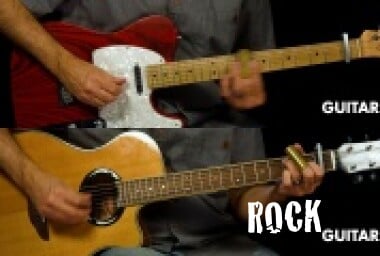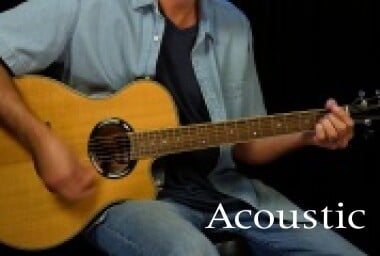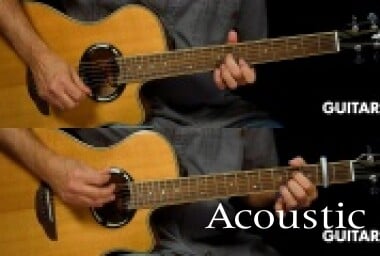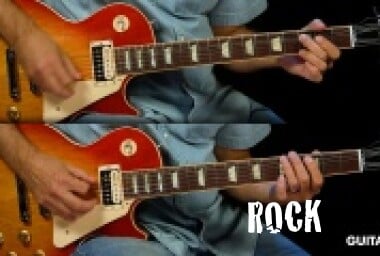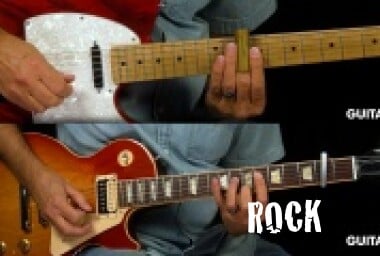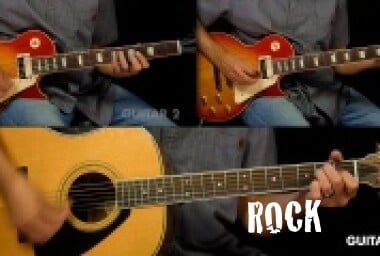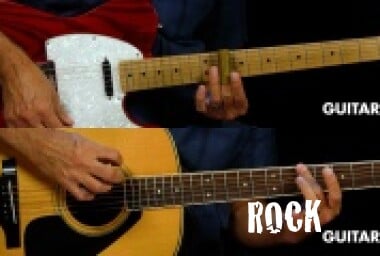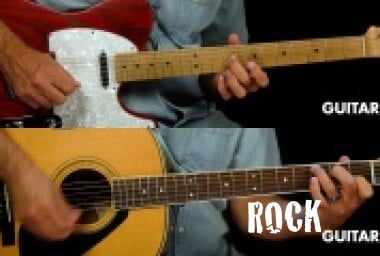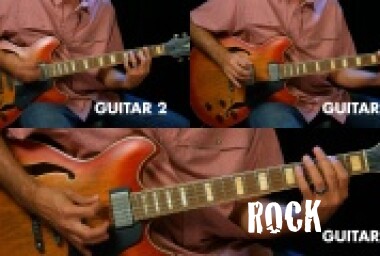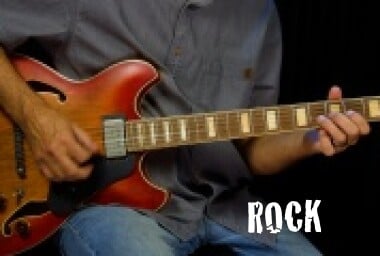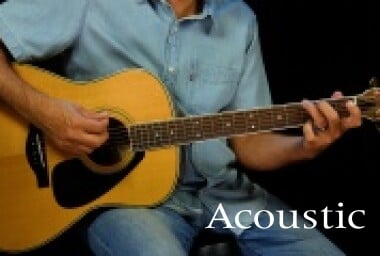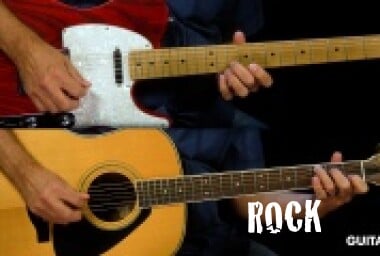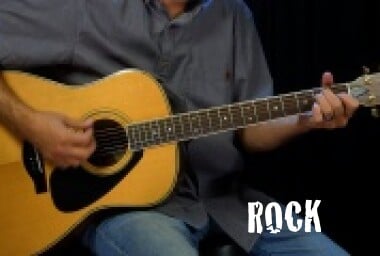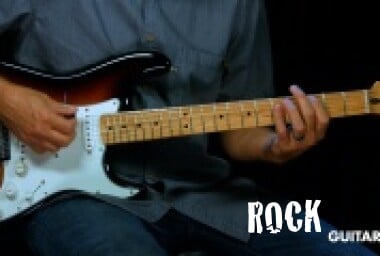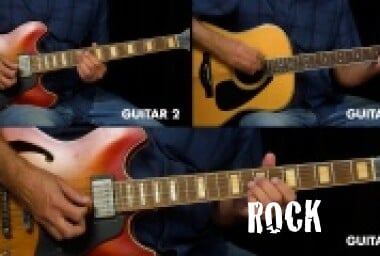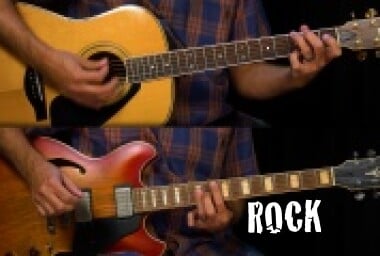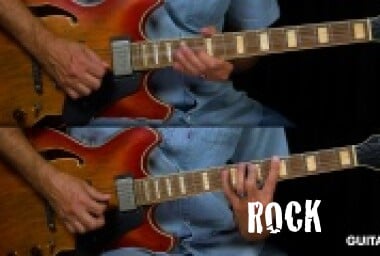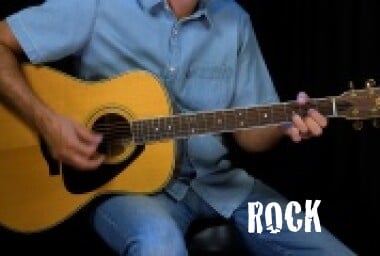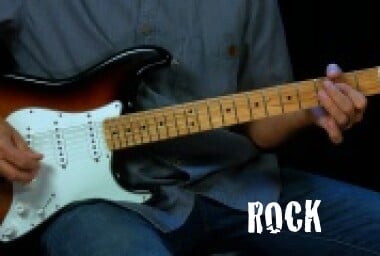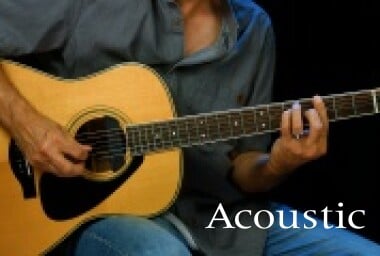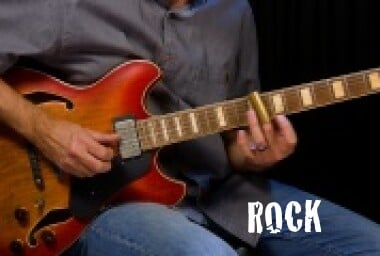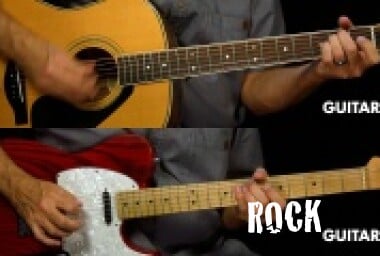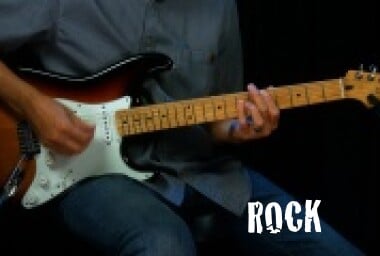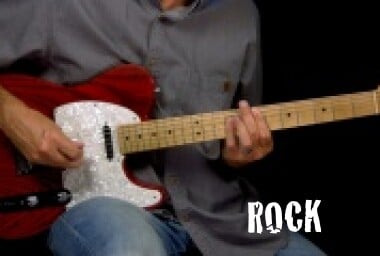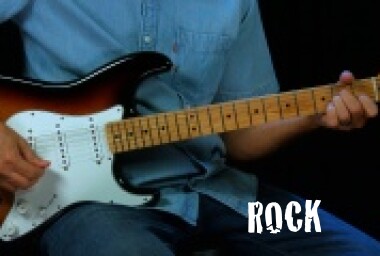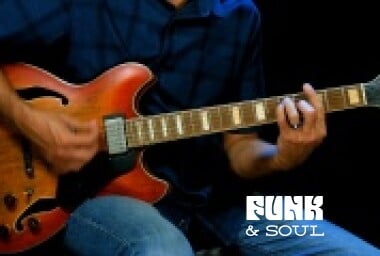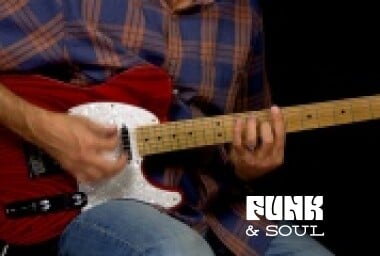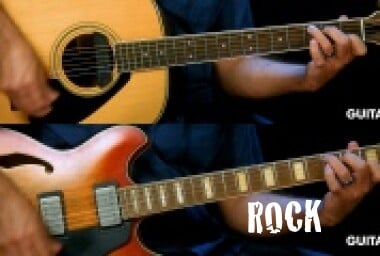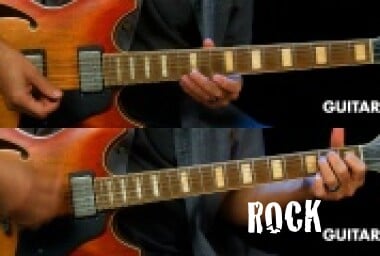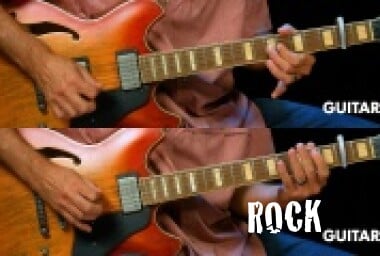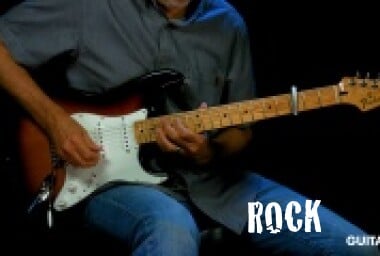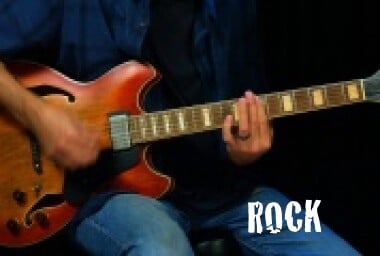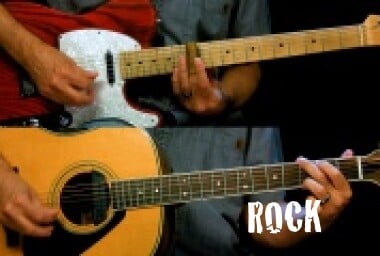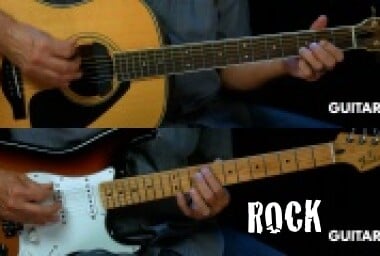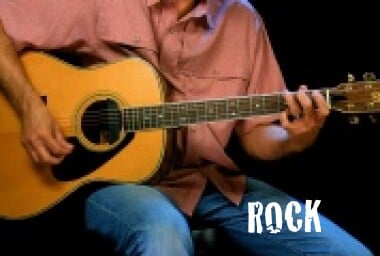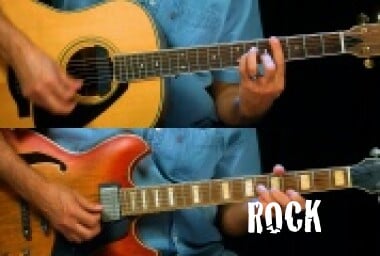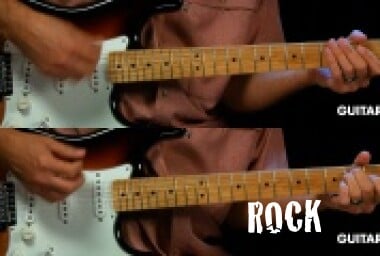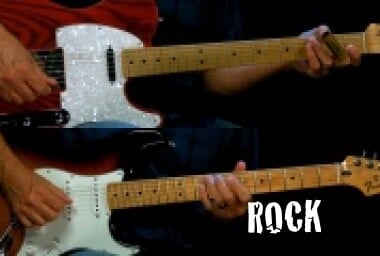Song Lesson Library
Search through our guitar song library to find your favorite guitar songs to learn. Our song library boasts hundreds of individual songs including Beatles songs, Rolling Stones songs, Eagles songs, top country songs, Eric Clapton songs, AC/DC songs, a TON of beginner guitar songs, and much more! You won't simply learn the chord progression to your favorite tunes; we break down every guitar melody, song section, each guitar part and guitar solos note-by-note so you can be sure to learn your favorites inside and out.
Sort by category
Filter by difficulty
This tune features an acoustic guitar strumming the progressions and also adding plenty of lead embellishment and even a full guitar solo! There is also a pedal steel heard prominently in the mix, so we’ve adapted these ideas into clean electric guitar parts. This song uses open and barre chords, steady acoustic strumming, pedal steel influenced lead ideas, and some fiery acoustic lead approaches.
Published: 04/18/2024 UpgradeThis song features one acoustic guitar that strums the progressions and embellishments throughout. Any acoustic guitar can be used to play this song. You’ll need a capo placed on the 1st fret to play along with this tutorial. This song uses open chords, the use of a capo, and dynamics.
Published: 04/11/2024 UpgradeThere are 2 clean electric guitars in this tune. Guitar 1 plays main rhythm parts, while Guitar 2 adds some lead fills in the chorus. The tune features a harpsichord that plays the main riff, and we’ll adapt it for guitar. This song uses triads, doubles stops, and barre chords, steady strum approaches, chord arpeggiation, and some early rock lead approaches.
Published: 04/04/2024 UpgradeThis tune features 1 acoustic and 1 electric guitar. The acoustic strums the chord progressions and adds some slide ornamentations and riffing to provide a rich rhythm guitar bed. The electric guitar adds more slide fills to the arrangement. This song uses an open E tuning, a capo, strumming and riffing techniques, a swung eighth groove, dynamics, and some textbook slide lead approaches.
Published: 03/29/2024 UpgradeThere is 1 acoustic guitar that lays down the foundation of the tune with chords and strumming. This song uses barre chords and steady strumming techniques.
Published: 03/22/2024 UpgradeThe song features two acoustic guitars. Guitar 1 has a capo on the 2nd fret and plays a combination of chord strums, arpeggiation, and ornamental fills. Guitar 2 does not use a capo, and plays leads and fills throughout the song. This song uses a capo, open chords, strumming with a swung eighths groove and adding embellishments, as well as some textbook acoustic licks and fills.
Published: 03/15/2024 UpgradeThere are 2 electric guitars in this tune. Guitar 1 plays the main riff and solo in the song, while Guitar 2 adds some rhythm guitar with a few tasty lead fills. This song uses single note riffs, solid rhythm strumming, and tasty rock lead approaches.
Published: 02/29/2024 UpgradeThere are 2 electric guitars in this song. Guitar 1 plays the rhythm riffs, while Guitar 2 digs into some slide fills using Open E tuning. You’ll need a capo and slide to play along with this tutorial. This song uses a capo, open chords and triads, suspended chord embellishments, and some basic slide guitar approaches.
Published: 02/22/2024 UpgradeThis tune features 1 acoustic and 2 electric guitars. The acoustic strums the main riffs and chord progressions throughout. One clean electric guitar add single note lines, backbeat chord stabs, and a bluesy solo. The other electric guitar has a fuzz effect and adds some ornamental single notes to the arrangement. This song uses open and barre chords, steady acoustic strumming, single note riffing, and some bluesy lead approaches.
Published: 02/16/2024 UpgradeThis tune features 1 acoustic and 1 clean electric guitar. The acoustic strums the chords throughout, while the electric adds simple slide licks to add some texture to the arrangement. Both guitars use an Open E tuning. This song uses open tuning chord shapes, solid acoustic strumming approaches, dynamics, and some simple slide licks.
Published: 02/09/2024 UpgradeThis tune features 1 acoustic and 1 clean electric guitar. The acoustic strums the chords throughout, while the electric adds strums and single note motifs to add texture to the arrangement. This song uses open chords and suspended chord embellishments, strumming with an 8th note triplet swing groove, and double stops and triads.
Published: 02/01/2024 UpgradeThere are 3 clean electric guitars in this song. Guitar 1 plays the iconic riffs throughout, while Guitar 2 adds a layer of solid strumming to the arrangement. Guitar 3 adds some single note lines to the chorus and bridge to add additional excitement. This song uses single note riffs, dominant 7th chords, barre chords and power chords, solid strumming approaches, palm muting, and some early rock lead licks.
Published: 01/26/2024 UpgradeThis tune features 1 lightly overdriven electric guitar that plays boogie riffs and chord stabs throughout. This song uses boogie rhythms, triads, chord strums with muting, and dynamics.
Published: 01/25/2024 UpgradeIn this tutorial we will learn a solo classical guitar arrangement of Frederic Chopin's 'Grand Waltz' Opus No. 18, No. 1 piano piece.
Published: 01/20/2024 UpgradeThere is no guitar on the original recording, but we’ll add an acoustic guitar into the mix and play the chord progressions with a consistent strum. Any guitar can be used to play along with this tutorial. This song uses open chords, and a steady strumming approach.
Published: 01/18/2024 UpgradeThis tune features 1 acoustic guitar and a dulcimer that we’ll adapt for a clean electric guitar. The acoustic arpeggiates the chord progressions throughout, while the dulcimer parts play high register octave melodies. We’ll use a special tuning on the electric guitar to get closer to the vibe of the dulcimer heard on the recording. This song uses open chords, chord arpeggiation, and octaves.
Published: 01/11/2024 UpgradeThis tune features 1 acoustic and 2 electric guitars. The acoustic strums the main riffs and chord progressions throughout. One overdriven electric guitar digs into riffs and rhythms, while the other adds some lead fills to the arrangement. This song uses melodic riffing, solid acoustic strumming, open and barre chords, and tasty fills and licks.
Published: 01/04/2024 UpgradeThere are 2 electric guitar in this song. Guitar 1 uses both clean and dirty tones to play the rhythm riffs throughout. Guitar 2 is an additional guitar that adds some power to the outro chorus. This song uses open chords and power chords, a solid strummed approach, and dynamics.
Published: 01/02/2024 UpgradeThis tune features 1 acoustic and 2 electric guitars. The acoustic strums the chord progressions throughout, while the electrics adds plenty of riffing with chords, single notes, and double stops. One of the electrics also digs into a great solo. This song uses double stops, boogie riffing, open chords with solid acoustic strumming, and some simple lead licks.
Published: 12/28/2023 UpgradeThis tune features 2 electric and 1 acoustic guitar. The electric plays fuzzed out power chords and lead fills throughout, while the acoustic strums the chords throughout. There is a 2nd electric guitar in the intro that adds a simple lick with a filter effect. This song uses power chords, open chords, steady strumming patterns, and lead fills.
Published: 12/21/2023 UpgradeThere are 2 electric guitars in this song. Guitar 1 lays the foundation with a rhythm riff throughout the song, while Guitar 2 digs into some exciting blues rock licks and fills throughout. This song uses boogie riffing using power chords, steady strum approaches, and some killer early rock licks.
Published: 12/14/2023 UpgradeThis tune features 1 acoustic and 1 electric guitar. The acoustic strums the chord progressions throughout, while the electric adds single note parts to add some texture to the arrangement. This song uses double stops, single note motifs, open chords and steady acoustic strum approaches.
Published: 12/07/2023 UpgradeThere are 2 electric guitars in this song. Guitar 1 lays the foundation with a rhythm riff throughout the song, while Guitar 2 digs into some exciting blues rock licks in the solo. This song uses barre chords, blues based riffing, steady strum approaches, and some killer early rock licks.
Published: 11/30/2023 UpgradeThere is 1 electric guitar in this song that switches between clean and distorted tones throughout. You’ll need to tune your guitar one half-step down, then drop the low string an additional whole step to play along with this tutorial. This song uses dropped tuning power chords, combining chord strums with single note motifs, melodic lead approaches, and dynamics.
Published: 11/22/2023 UpgradeA 12 string acoustic guitar was used on the original recording, but any guitar - acoustic or electric can be used to play this song. This song uses barre chords and open chords, chord arpeggiation, and steady strumming approaches.
Published: 11/22/2023 UpgradeIn this tutorial we will learn a classical guitar style arrangement of the main themes from the 'Nutcracker March' by Tchaikovsky.
Published: 11/20/2023 UpgradeThere are 3 guitar layers in this song. Guitar 1 is a clean electric guitar that plays some solid rhythm riffing throughout. Guitar 2 is an overdriven electric guitar that adds some tasty lead work. Guitar 3 adds some harmony leads to the outro solo. This song uses extended chords, syncopated strumming, and some textbook classic rock soloing.
Published: 11/16/2023 UpgradeThis tune features 1 acoustic and 1 clean electric guitar. The acoustic strums the chord progressions, while the electric adds slide fills using an open A tuning. You’ll need a slide to play along with the electric parts in this tutorial. This song uses open chords and barre chords, 16th note syncopated strumming, slide approaches in an open tuning, and dynamics.
Published: 11/16/2023 UpgradeThis tune features 1 acoustic and 1 clean electric guitar. The acoustic strums the chords throughout the tune, while the electric adds arpeggiated notes and lines. This song uses open chords, an eighth-note triplet strumming pattern, simple riffing off of root notes using slides, and palm muted arpeggiations.
Published: 11/09/2023 UpgradeThere are 3 electric guitars in this song. Guitar 1 is the main rhythm guitar that plays simple riffs throughout the tune. Guitar 2 is the lead guitar that digs into plenty of bluesy solos, while Guitar 3 is a clean electric guitar that plays some single note lines and diad riffs throughout. This song uses barre chords and power chords, funky diad riffing and single note lines, and some textbook bluesy rock soloing.
Published: 11/02/2023 UpgradeThe tune features 1 acoustic and 1 clean electric guitar. The acoustic strums the chords throughout, while the electric adds some country and blues tinged riffing to add texture to the arrangement. This song uses open chords and extended chords, strumming with a country swing groove, double stops, and bluesy riffing approaches.
Published: 11/02/2023 UpgradeThere is just one electric guitar in this song arpeggiating and strumming the iconic progressions throughout. This song uses open chords, chord arpeggiation and strumming with a 12/8 feel, and dynamics.
Published: 10/26/2023 UpgradeThere is 1 clean electric guitar in this song that strums the progressions with a laid back swing groove. This song uses barre chords and extended chords, and steady strums with a swing groove.
Published: 10/19/2023 UpgradeThere is 1 clean electric guitar in this song that strums the progressions with a laid back swing groove. This song uses barre chords and seventh chords, and steady strums with a swing groove.
Published: 10/12/2023 UpgradeThere are 4 guitar layers in this song. Guitar 1 is a clean electric guitar that strums the chord progressions throughout, while Guitar 2 is an acoustic guitar that adds another layer of strumming. Guitars 3 and 4 are clean lead guitars that add a quick melodic motif to the arrangement. This song uses open chords and barre chords, chord arpeggiation, quick hammer-ons, and some solid strumming approaches.
Published: 10/05/2023 UpgradeThere are two electric guitar layers in this song. Guitar 1 provides the foundation of the tune, playing riffs and strumming chords so hard the strings are getting pulled out of tune! Guitar 2 adds some aggressive lead guitar and wild guitar noises to the fray. This song uses rock riffing, aggressive strumming, and some great lead guitar.
Published: 09/21/2023 UpgradeIn this tutorial we will play a solo classical guitar arrangement of the main theme to Tchaikovsky's 'Pathetique' Symphony.
Published: 09/20/2023 UpgradeThere are 2 unique sounding, fuzzed out electric guitars that dig into some aggressive riffing and leads throughout the arrangement. You’ll need a capo placed at the 2nd fret to play along with this tutorial. This song uses boogie riffing, a swung 8ths feel, double stops and power chords, and some aggressive lead guitar approaches.
Published: 09/14/2023 UpgradeThe tune features 1 clean electric guitar that plays mostly staccato chord stabs throughout. There is also an electric dulcimer on the recording that we’ve adapted over to an electric guitar. You’ll need a capo placed on the 3rd fret to play these parts. This song uses extended chords and barre chords, staccato stab strums, and the use of a capo.
Published: 09/14/2023 UpgradeThere is 1 slightly overdriven electric guitar strumming chords and riffs throughout the tune. The guitar is tuned to open D tuning. This song uses open D chord shapes and embellishments, and some steady strummed approaches.
Published: 09/07/2023 UpgradeThere are 2 guitars in this tune. Guitar 1 is an acoustic guitar that strums the chord progressions throughout. Guitar 2 is a clean electric guitar that adds some fills later in the arrangement. This song uses open chords and barre chords, dominant seventh chords, double stops, steady acoustic strumming, and dynamics.
Published: 09/07/2023 UpgradeThe tune features 1 acoustic and 1 clean electric guitar. The acoustic strums and riffs throughout the tune, while the electric adds some slide guitar embellishment with open G tuning. This song uses open chords, steady strumming, chord embellishments and riffing, and some simple slide approaches in an open tuning.
Published: 08/31/2023 UpgradeThere are 2 guitars in this song. Guitar 1 is an electric guitar that switches between clean and crunch tones throughout. Guitar 2 is an acoustic guitar that adds an additional texture to the arrangement. You’ll need to tune your guitar ½ step down, then drop the low string an additional step to play along with this tutorial. This song uses single note riffs, dropped power chord shapes, steady acoustic strumming approaches, and dynamics.
Published: 08/24/2023 UpgradeThis tune features 1 acoustic and 1 clean electric guitar. The acoustic strums and arpeggiates the chords, while the electric plays single note riffs and light chord strums throughout. This song uses open chords, steady strumming, chord arpeggiation, and single note riffing.
Published: 08/24/2023 UpgradeThis tune features 1 electric and 1 acoustic guitar. The electric guitar plays staccato chord stabs and fuzzed out power chords, while the acoustic strums barre chords throughout. This song uses open and barre chords, triads, and staccato strumming.
Published: 08/17/2023 UpgradeThere are 2 electric guitars in this song. Guitar 1 holds down the rhythm with plenty of chord embellishments and fills, while Guitar 2 adds sparse fills and the main solo. This song uses open chords and barre chords, strummed rhythm approaches with embellishments and fills, and some textbook bluesy rock leads.
Published: 08/10/2023 UpgradeThe tune features 2 slightly overdriven electric guitars. Guitar 1 plays the main rhythm, while Guitar 2 uses open D tuning to play a simple slide riff throughout. This song uses a blues shuffle feel, boogie riffing, dynamics, and slide with an open D tuning.
Published: 08/10/2023 UpgradeThe tune features 2 clean electric guitars. Guitar 1 plays the main rhythm, while Guitar 2 is a 12 string electric guitar that adds some single note melodies throughout. A 12 string guitar is ideal, but not necessary to play these parts. This song uses double stops, open chords, single note ornamentations, and some steady strumming approaches.
Published: 08/03/2023 UpgradeThe song features one acoustic guitar that plays a main riff and strums chord progressions throughout. Any acoustic guitar can be used to play this song. You’ll need a capo placed at the 3rd fret to play along with this tutorial. This song uses a capo, single note riffing, open chords, and steady strum approaches.
Published: 07/27/2023 UpgradeIn this tutorial we will learn a solo classical guitar arrangement of Johann Strauss's 'The Blue Danube' waltz theme in classical guitar style.
Published: 07/20/2023 Upgrade